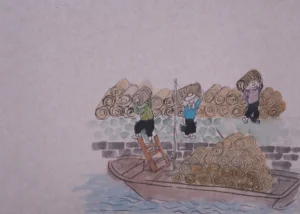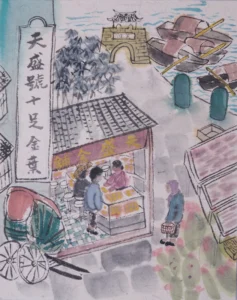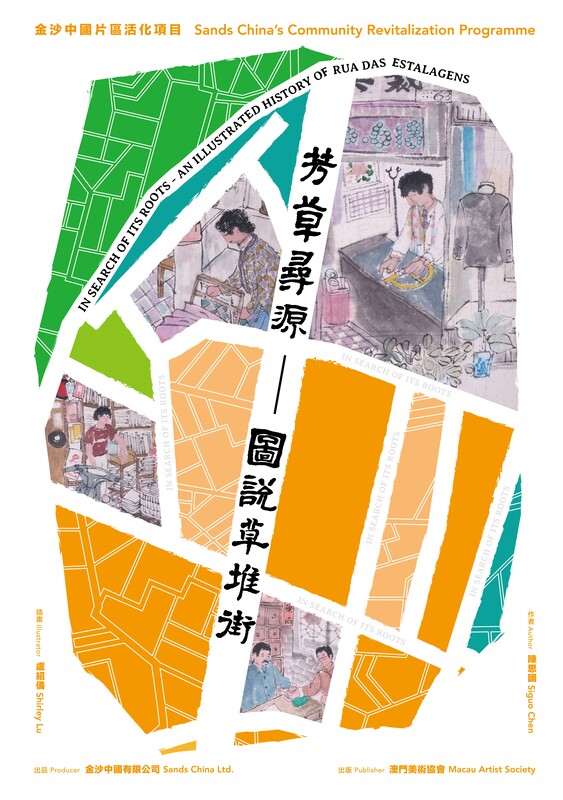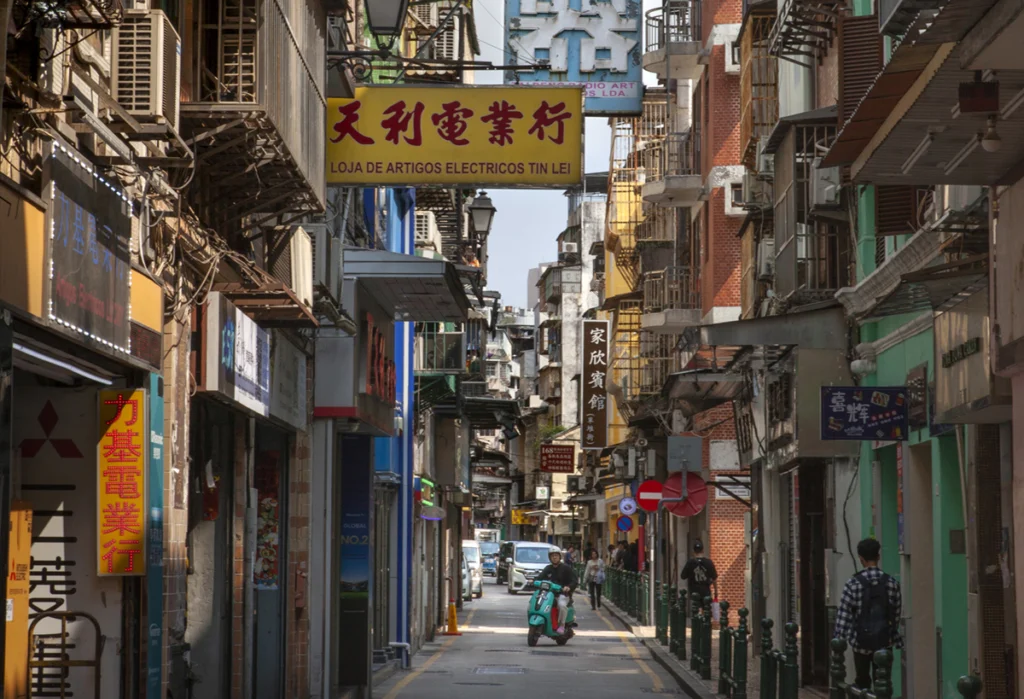Once a bustling hub of artisans and traders, Rua das Estalagens now welcomes a new wave of entrepreneurs blending tradition with fresh ideas. Sands China has released the bilingual publication In Search of Its Roots – An Illustrated History of Rua das Estalagens, uncovering the stories of this historic lane and inviting both Macau residents and visitors to rediscover its century-old shops and rich cultural atmosphere. Each month, Plataforma and Sands China are highlighting the community, businesses, and revitalisation efforts that are breathing new life into one of Macao’s oldest streets. Through captivating stories, we explore its transformation, honoring its past while shaping its future. Each report will be published in Chinese, English, and Portuguese on the last Friday of every month in print and digital formats.
A Historical Perspective

Rua das Estalagens was the main connection between the Inner Harbour and Macao’s urban center. Until the opening of Avenida de Almeida Ribeiro in 1918, it was the busiest route for traders and workers. Crónicas Macaenses
The history of Rua das Estalagens dates to 1557 when the Portuguese arrived. At that time, it was not even a street—just a tidal flat known as “Chou Toi” (pile of grass), where firewood and grass brought from the Xijiang River were unloaded and transported to Rua da Palha for fuel, construction materials, and feeding military horses and mules.
Its function changed in 1684 when the Qing dynasty lifted maritime trade restrictions for foreign merchants. Macao became a strategic hub for Chinese global trade. As commerce expanded, the need for infrastructure grew, leading to land reclamation in previously flooded areas.
At different times, a dozen or even twenty shops from the same sector gathered here, something that other old neighborhoods did not have
Siguo Chen, author of the book In Search of Its Roots – An Illustrated History of Rua das Estalagens

During the Ming dynasty, Rua das Estalagens served as an unloading area for firewood and grass, which gave it its first Cantonese name “Chou Toi.” Illustration from In Search of Its Roots – An Illustrated History of Rua das Estalagens.
In 1817, during the reign of Emperor Jiaqing, a Cantonese merchant received permission from the Xiangshan County magistrate to build the first permanent shops in the area. Soon after, more merchants followed, leading to the establishment of over 60 commercial businesses on the street.
This marked the transition from an informal marketplace to an organised commercial district, which quickly became one of Macao’s main economic and political hubs, alongside Rua dos Mercadores and Rua dos Ervanários.
“At different times, a dozen or even twenty shops from the same sector gathered here, something that other old neighbourhoods did not have,” says Siguo Chen, responsible for documenting the street’s history in the book In Search of Its Roots – An Illustrated History of Rua das Estalagens.
The name Rua das Estalagens reflects the street’s function in the 19th century, as inns (estalagens in Portuguese) emerged to accommodate traders and travelers in transit. The area became a key hub for textile and jewelry commerce, attracting tailors and goldsmiths serving both the local elite and foreign merchants.

Fishing boats regularly stopped at the Inner Harbour, allowing fishermen to visit Rua das Estalagens to buy gold. Illustration from In Search of Its Roots – An Illustrated History of Rua das Estalagens.
Among the most renowned establishments were Ngan Kong Fabric Company and Tin Seng Jewellery, both still in operation today. In 1893, the arrival of young doctor Sun Yat-sen, who opened Chong Sai Pharmacy, cemented Rua das Estalagens in China’s political history.
By the early 20th century, Rua das Estalagens was the primary connection between the Inner Harbour and Macao’s urban center. Until Avenida de Almeida Ribeiro opened in 1918, it remained the busiest route for traders and workers.
During the 1920s, approximately 75% of Macao’s population (60,000) was involved in the fishing industry, and the gold shops on Rua das Estalagens played a crucial role. For fishermen, gifting gold to family and friends was a traditional practice and a secure way to store wealth for long sea voyages.
“Although gold shops are now more concentrated around Avenida de Almeida Ribeiro and Avenida do Infante D. Henrique, between 1900 and 1990, Rua das Estalagens was extremely prosperous. Even after Avenida de Almeida Ribeiro opened, Rua das Estalagens still had more gold shops,” says Siguo Chen, recalling how the street “contributed significantly to Macao’s economy and held an important position in its centuries-old history.”

The memory of Rua das Estalagens lives on, blending century-old buildings and businesses with new ventures. Plataforma
The street became less prosperous following the relocation of the Inner Harbour’s cargo terminal, which caused new commercial centers to emerge, drawing customers away.
The textile sector, once strong on Rua das Estalagens, declined due to industrialisation and competition from modern shopping malls. Many shops closed, and the street lost its vibrancy—exacerbated in recent years by the Covid-19 pandemic.
However, the memory of Rua das Estalagens remains alive, with its historic buildings and businesses now blending with new enterprises, thanks to Sands China’s revitalisation efforts. This initiative, supported by the government and the local community, is helping to restore Rua das Estalagens to its former glory while adapting to modern demands.
Shaping the Future
Last April, Sands China took one of the first steps in revitalising Rua das Estalagens as a bold initiative to breathe new life into the historic street. The company launched the Community Revitalisation Series – Entrepreneurship Recruitment Programme. Out of 600 participants and 120 eligible applications, seven projects were chosen.
Six businesses are already operating on Rua das Estalagens since July 15, 2024. The remaining business is set to open this summer.
Beyond supporting new entrepreneurs, revitalisation efforts have also benefited traditional businesses. Several historic storefronts have been “beautified” as part of a partnership between Sands China and the Macau Artist Society, aiming to gradually create a new ecosystem in the area.
Another crucial aspect of this project is community involvement. Sands China has been working closely with the Chou Toi Six-Neighborhood Association, ensuring that the revitalisation efforts respect for traditional, particularly for those who have lived and worked in the area for decades.
More than just a passageway, this project seeks to reestablish Rua das Estalagens as a gathering place. Its new era is being written as a symbol of resilience—for this generation and the ones to come.
“As time marches on, Rua das Estalagens has grown even more precious for its unique community spirit and heritage. Walking its lanes feels like stepping back through time, while the enduring sense of community and neighbourly support from previous generations has remained intact over time. The shops that are still standing along the street are not just places of business; they are treasure troves of neighbourhood nostalgia and shared memories, holding countless fascinating stories for those who take the time to explore them,” according to the preface of In Search of Its Roots – An Illustrated History of Rua das Estalagens

Learn more about In Search of Its Roots – An Illustrated History of Rua das Estalagens
- Producer: Sands China Ltd.
- Publisher: Macau Artist Society
- Author: Siguo Chen
- Illustrator: Shirley Lu
Be sure to check back on April 25 when we examine how community leaders are strengthening the local fabric of the street.








